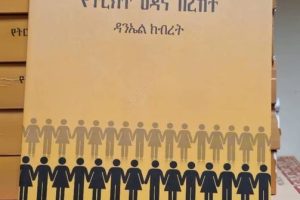
Addis Ababa is becoming one of the hottest cities in Africa and the largest one in East Africa by the size of its population, its economic significance, and the fast expansion of the metropolis in general. The city’s skylines are changing constantly with high rises emerging everywhere and its architecture undergoing unprecedented or continuous modification. What makes Addis more different from other African cities is the fact that it is caught in an uninterrupted process of demolition of old buildings, the renovation of not-so-old structures and the construction of new, and most of which are state-of-the-art ones. In the meantime, the city is fast losing its bustling characteristics and assuming a more serene appearance.
As the saying has it, one man’s gain may be another man’s loss, that is to say in a business where profit and loss are regulated by the market. We can perhaps apply this adage to the present realities of renovation that is taking place in many places in Addis where the construction of new high rises has led to the eviction or disappearance of small businesses, particularly small bookshops that thrived in their shadows. As loss and profit is an inevitable aspect of the market, construction, and demolition are going hand in hand in a city that is engaged in a feverish pace of modernization that does not seem to take the costs into its account.
There are winners and losers in the process of this renovation frenzy. Nowadays urban renewal is less a matter of wholesale destruction of old buildings and structures. Urban renewal is expected to create as many jobs as those lost in the process. According to available information. “Urban renewal is a policy based less on destruction and more on renovation and investment and today it is an integral part of many local governments.”
When entire neighborhoods disappear they take away with them not only the bookshops as physical infrastructures. Owners of the shops lose their sources of income and their families are bound to suffer as a result of this.
Addis Ababa’s renovation may be a boon to the city’s development but it is proving a loss for culture, particularly on books and reading. There were at least three major areas in Addis where bookshops were thriving starting back in the 1990s and 2000s. This includes first the areas behind the National Theatre, and across the road leading to the former commercial printing press.
The second place was located on the other side of the National Theatre and around the old Lion Bar that has given place to the construction site behind Ethiopia Hotel. The National Theatre was thus surrounded by strings of open-air bookshops, near Ras Hotel. There, books are sold on the corridors where, in former times, the area was known for its high-class shops, cafes, and other businesses.
Piassa, and more particularly, the area around St. George church, was known to be a market for books, new and old, that are sold in small shops, almost the size of bird cages. Most of them have now moved to the adjacent location behind the church on the way to Merkato. Bookshops in areas strategically located at major road junctions, or in crowded places where the book market is relatively more promising. By definition, the best location for a bookstore is “in an area that has high foot traffic, is easily accessible, and has a strong demand for books.” It has to be a location that is visible from the street, has ample parking, and is located near other businesses that attract a lot of people.
Modern bookshops are few and located around the posh areas of the capital with high-class neighborhoods whose educated inhabitants have both the culture of book reading and the financial muscles to buy expensive and mostly imported books. ‘Bookworld’ along Bole Road is such an outlet with a few branches dotting the capital.
The most prominent book distribution outlet is Jafar Books which has many shops located on the ground floors of new buildings. Jafar is not only a major book distributor but also a publisher on the side, although this aspect of the business is little known by the public. Owned and managed by an entrepreneurial young man whose business acumen is well-publicized around the capital, Jafar Books has major distribution outlets in many parts of the capital. As some of the former distributors have either gone out of business, have become full-time publishers, or owners of printing houses, Jafar seems to have chosen his tried and tested specialty as a book dealer or distributor. This is a relatively safer and almost risk-free sector in an industry often hit by bankruptcies and closures of book outlets. By the way, Jafar is also the largest book seller in Ethiopia.
Speaking of bookshops, Addis actually boasts of some17 bookstores located in various parts of the city. This is not of course a big deal for a city that has more than 5 million inhabitants and serves as the diplomatic capital of Africa with a large foreign community.
Coming back to the Ethiopian capital after a long stay abroad or in the regions is usually replete with many surprises. These days, Addis is changing faster than any time before, so much so that you tend to forget some of the milestones and the buildings that were familiar to you in the old days. Old buildings are being renovated radically and they rather look like new ones. The change is not cosmetic. It is rather radical, that is to say, the building materials, the structures, and the colors are changed, giving the buildings new looks, or the appearance of newness.
The city section that is known as Arat Kilo, the area around Victory Square and the Ministry of Education, and the premises of the Berhanena Selam printing press, have changed expectations. The road is broader and cleaner and the pedestrian alleys are equally cleaner and well-designed. The entire area breathes a sense of newness. This gives you the impression that you are visiting the place for the first time or that you are in a place you did not know before.
July and August in Addis are months of heavy rains. Traditionally, these were also months of cultural activities such as book exhibitions and other artistic displays. The vacation season provides students and youngsters in general, opportunities for engaging in these activities. Times are changing and these days we do not see anything resembling the activities of the previous years. Maybe the construction shakeup might have disrupted the possibility of organizing cultural activities that are not obviously the top priorities of the city authorities.
As you know, the rainy season in Addis is not the best season for outdoor activities. Heavy rains that started from July and continue well into September prevent people from enjoying outdoor activities and engage in sports such as soccer. Stadiums are closed and recreational activities are scarce. Reading may be the best option but conditions are not suitable for people to read. There are not many public libraries while the internet has made it possible for book lovers to enjoy reading digital versions of the books they like. This has made going to the libraries in the rainy season or enduring the cold something superfluous. The galloping inflation does not give people the rare luxury of using their pocket money to buy books as they used to do in the days long gone.
Cultures, and more particularly books, are part and parcel of our daily diet of the mind. Culture is an important and even decisive aspect of existence as individuals, communities, or nations. If we look around at the objects that surround us, we realize that we find at least one item of culture standing somewhere although we often overlook its existence. This may be an old bookshelf filled with old and dusty books. It may be an artifact sitting on the table as an object of decoration. It can also be a traditional cultural item that is hanging on the wall as an object of reminiscence or decoration. Anyway, culture is everywhere with us whether we like it or not.
This is what makes culture precious and cultural objects the components of our daily lives. We should therefore look at urban development with a holistic approach and not fall in the pitfall of misconceptions. A building is nothing but a collection of bricks, cement and steel unless it reflects some cultural or traditional aspects of our past history as well as our present. That is why it would be a mistake to do away with a traditional building or memorial item to give way to the construction of a new hotel or recreational centre.
Bookshops not only contains stacks of papers but also our traditions, cultures and dreams that are part of our legacy. That is why we should take care of these items whenever we plan to renovate our environment. As a city without books and bookshops is incomplete, a rainy season is colder and sadder without books not as decorative items but as builders of our minds and souls.
BY MULUGETA GUDETA
THE ETHIOPIAN HERALD SATURDAY 27 JULY 2024





